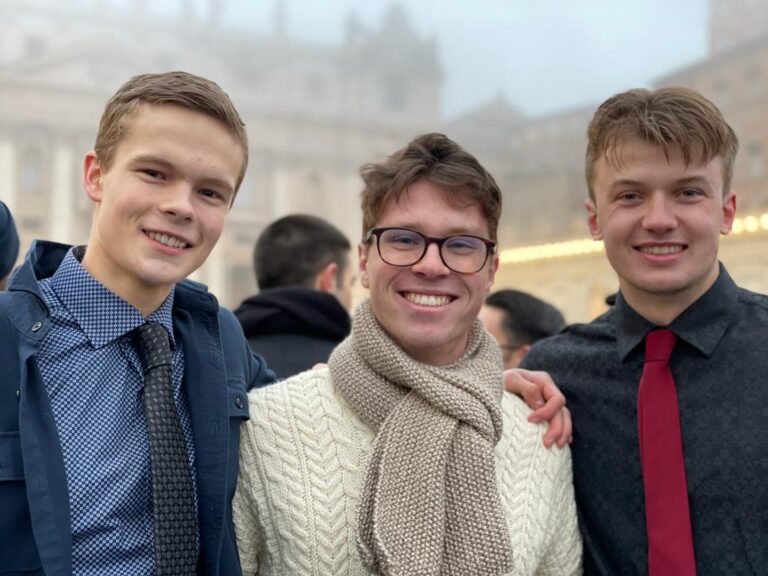A New Perspective: Students Attend Pope Benedict XVI’s Funeral

Since 2019, Dean John Pell (John) and Dr. David Emerson (Bert) had been planning to lead a trip through Italy over Jan Term. After countless delays on this project, the time had finally come. Nineteen freshman, one sophomore, and three upperclassmen TAs joined the two faculty and their families to explore art and rhetoric abroad. Three days before we were scheduled to land in Rome, however, we received news that Joseph Ratzinger, commonly known as Pope Benedict XVI, had passed away.
Shortly before leaving, our professors reached out to the group to inform us of the pope’s death. Bert suggested we contemplate the nuance that this would add to our trip. While we considered the possibility of seeing the pope’s body lying in state, attending the funeral seemed unrealistic.
On January 4th, the last day the pope’s body was lying in state, Jack Ireton, ‘26, hopped in line outside Saint Peter’s Basilica to pay his respects. While waiting to get in, he began chatting with a group of English speakers. This group of young men was composed of an ordained priest named Fr. Boslter as well as half a dozen seminary students originally from Nashville. These students were attending a prestigious Roman school in pursuit of ordination in the Catholic Church.
After chatting in line for about an hour, the group invited Jack to the papal funeral the following day. They told him to bring along any Whitworth friends who were willing and able to come.
Later that night, the rest of the study group met the same Catholic students on the bus, and they again extended the invitation to the funeral. This was a sign that they had been genuine in their offer. After discussing the prospect of going to the funeral with Dr. Pell, nine of us got up early in the morning to make our way over to St. Peter’s Square.
After two security checkpoints, many phone calls with Jimmy (one of the Catholic seminary students), more conversations with English-speakers while in line, and lots of standing, we found seats that were less than a hundred meters from the front. We were about as close as a lay person could be.
For another hour, we sat and spoke with the students. They led us in morning prayer, spoke at length about the history of Benedict’s papacy, and impressed upon us the impact of his theology on the church.
At around 8:50, the service began with the Rosary. As a group of Protestant students, we did not know what to expect at this funeral in the first place, but after 20 minutes of “Ave Maria” followed by a lot of Latin that none of us understood, we knew we were in for a unique experience. It took 45 minutes to get us to page 2 of the 71-page liturgy guide.
Afterward, Jack said that he felt much like Merry and Pippin in Fangorn Forest wondering what the Ents were saying to each other. In the middle of Tolkein’s epic, the two hobbits asked Treebeard what they were saying, and he told them they had just finished saying “good morning”.
Thankfully, the pace of the mass increased soon after. We had expected to not understand a word of the service, but it turned out that the liturgy guide included English translations. Our Catholic friends helped us out with some of the Latin, too.
Prayers, antiphonal singing, a brief homily, a few scripture readings, and the Eucharist comprised the bulk of the service. All told, the service lasted about two and a half hours. With knees sore from kneeling on the cobblestone, we left the square surrounded by 100,000 of the faithful from around the world.
Back in 2013, Benedict was the first pope to resign in nearly six hundred years. Pope Francis has also spoken about resigning from the papacy. This was the first funeral of a former pope presided over by the sitting pope—perhaps the first of many.
Attending the funeral broadened our perspective of the Church and gave us a window into the ongoing, rich history of Catholicism that has been growing and changing for thousands of years. As an Anglican, Jack appreciated the familiarity of the liturgy and form that is presented in a new context. He respected the adherence to tradition that the Catholic church exhibited on this occasion. As a strong Presbyterian, there are many elements of the Catholic belief system that Oliver Hammond, ‘26, disagrees with. Despite this fact, Oliver found himself to be more like these Catholic students than he had anticipated. He found that he had more in common with these devout Catholics than he had with many “soft” Presbyterians, because of the passion these Catholics displayed. Overall, both students found the service to be a beautiful event. They were able to set aside our differences and worship together—at least for the most part.
